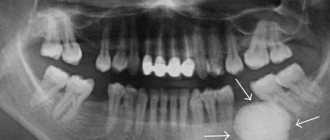Anatomical structure
The oral cavity is the initial section of the digestive tract, in which food is chewed and saliva is produced to digest food. It is involved in the process of breathing, swallowing, articulation and speech.
The composition of the oral cavity includes:
- vestibule (lips, front side of teeth, inner surface of cheeks);
- gums;
- the bottom on which the tongue lies;
- two thirds of the tongue;
- teeth;
- retromolar triangle - the space on the lower jaw behind the third molar;
- hard and soft palate.
Oral leukoplakia: how to treat it at home
In addition to drug treatment, oral leukoplakia can be treated with traditional medicine.
There are many recipes, here are just the main ones:
- rinsing with herbs (infusions of oregano, chamomile, ginseng and other adaptogens that reduce the inflammatory process and increase the body’s resistance to harmful factors are suitable);
- regular consumption of nuts and tinctures based on them;
- rinsing with decoctions of calendula, St. John's wort, eucalyptus. Alternation works well - once the oral cavity is rinsed with a soda solution, after a couple of hours - with an infusion of herbs. This procedure should be repeated at least 5 times a day;
- lubricating the lesions with sea buckthorn and olives (the fruits must first be mashed in your hands so that the juice appears).
Timely detection of the disease and compliance with all doctor’s recommendations is the key to recovery in the shortest possible time and reducing the risk of complications. If you start treatment at the initial stage, you can reduce the likelihood of complications to almost zero.
Classification
Oral cancer is divided into three types:
- papillary. The nodule in the mucous membrane increases in size and hangs into the oral cavity. The neoplasm progresses slowly;
- infiltrative. The seal on the pinkish mucosa is distinguished by a whitish color, clear contours and shape, and thinning of the membrane around it. On palpation from the side of the cheek, a dense infiltrate is felt. The tumor tends to grow rapidly. The patient complains of unbearable pain;
- ulcerative The most common form of the disease. Ulcers on the mucous membrane do not heal, they grow, and the border around them turns red. The outline is torn and its edges are bleeding.
Tumor metastases appear quickly. Malignant cells grow into the mental, submandibular, and deep jugular lymph nodes. This process is influenced by the thickness and depth of the tumor. Thus, when the tumor deepens by 4-5 mm, metastases occur in 98% of cases. At the T1 stage of oncology, metastasis is detected in half of the cases, and when the T4 stage is reached, distant spread of cancer cells is observed in 85% of cases.
Oral tumors: detection and treatment
REASONS FOR THE APPEARANCE
Tumors are divided into two groups: epithelial and nonepithelial.
The most common tumors are those that develop from glandular, flat, and tooth-forming epithelial tissue. Depending on their location, tumors of the gums, tongue, inner surface of the cheeks, hard and soft palate, as well as the salivary gland in the sublingual area are distinguished.
The causes of benign tumors of the oral mucosa are not entirely clear. Based on experience and observations, doctors give the following recommendations to minimize risks:
- Monitor the condition of chronic ulcers and cracks formed due to poor-quality dentures and crowns or injury to soft tissues from chipped teeth.
- Avoid using tobacco in any form. Its long-term use can lead to consequences in the form of a tumor.
- Avoid eating too hot foods, spices, alcohol and foods high in acids. This will prevent burns and irritation of the mucous membrane.
A timely visit to a specialist when the first symptoms are detected can save you from cancer: a dangerous disease that is difficult to treat.
TYPES OF NEW FORMATIONS
Neoplasms arise in various types of tissues of the oral cavity: connective tissues, bones, nerves and muscles. Some tumors cause irritation and discomfort. It is possible to notice them on your own, but often they are discovered only by a specialist during an examination. Benign tumors are divided into several types:
Epithelial:
Papillomas. They consist of stratified squamous epithelial cells localized on the tongue, lips, soft or hard palate. Papillomas resemble a protrusion on the mucous membrane with a smooth surface or papillary growths. Usually papillomas are single, but multiple ones are also found. Over time, they become overgrown with keratinized epithelium and become whitish and rough.
Nevi. In rare cases, they occur in the mouth. They are convex with varying degrees of pigmentation: from pink to brown. Some nevi can transform into melanoma.
Glands of Serres. They are located in the area of the alveolar process, resemble hemispherical dense formations of light yellow color, and can be multiple.
Connective tissue:
Fibroids. Often found in the tongue area, on the palate and lower lip. These are oval or round formations that are difficult to notice: their color blends with the mucous membrane.
Myomas. Usually develop from muscle tissue. Observed in the thickness of the tongue in the form of nodular formations.
Myxomas. They have a lumpy, rounded or papillary surface. Localized in the area of the hard palate and alveolar process.
Epulis. They arise on the gum, growing from its deep layers, as well as from the periosteum and periodontal tissues.
Pyogenic granuloma. It develops from the connective tissue elements of the oral cavity and from the mucous membrane after injury. It grows quickly, has a burgundy color, and bleeds when touched.
Neuromas. They are the result of the proliferation of Schwann sheath cells of nerve fibers. One of the few formations that causes discomfort upon palpation.
Vascular:
Hemangiomas. They are among the most common. They are divided into capillary, cavernous, capillary-cavernous and mixed. They turn pale or shrink in size when touched and may bleed.
Lymphangiomas. Appear due to disorders of embryogenesis of the lymphatic system. Often discovered in infancy. Visually they resemble swelling in the oral cavity, limited or diffuse. Prone to inflammation after injury to the mucous membrane or exacerbation of a chronic inflammatory disease of the nasopharynx.
At the first alarming signs, you should immediately consult a doctor for diagnosis and identification of neoplasms.
Tumor in the oral cavity: symptoms
The cause of the appearance of benign neoplasms in the oral cavity can be disturbances in the acid-base balance, neglect of hygiene, mechanical damage and bad habits. These risk factors are a serious reason to see a doctor for an examination.
There are several striking symptoms of the presence of a tumor:
- Discomfort when talking and eating.
- Unpleasant or painful sensations of a constant nature.
- Feeling of the presence of a foreign body.
Tumors do not cause any problems with your health, but you should not ignore the symptoms. Systematic irritation of the affected area can contribute to the degeneration of a neoplasm into a malignant one.
DIAGNOSIS AND TREATMENT
Oral tumors may be discovered by a dentist during an examination or treatment. Determining the depth of their germination is possible using ultrasound. X-ray examination is necessary to assess the condition of bone tissue. For gum fibromatosis, an orthopantomogram is performed to identify areas of destruction of the alveolar process.
Depending on the type of tumor, the following types of surgical treatment are used:
- Laser removal.
- Electrocoagulation.
- Cryodestruction.
- Surgical excision.
- Sclerotherapy.
There are diffuse tumors. They tend to grow rapidly and penetrate into the deep layers of the mucosa. Their removal is carried out in several stages. Fibromatous growths are excised along with the periosteum. Areas of affected bone tissue are treated with a milling cutter and also removed by coagulation (cauterization).
Vascular tumors are sclerosed by introducing special solutions into the tumor vessels. Active substances damage the walls of blood vessels, causing further scarring.
A tumor is a formation consisting of cells that have lost the ability to grow under controlled conditions. A separate branch of medicine—oncology—is devoted to neoplasms. This science studies the development, diagnosis and treatment of both benign and malignant tumors. A dentist can refer you to an oncologist to make an accurate diagnosis.
Extrodent specialists have a common goal: to preserve the health of patients in all available ways. This is possible thanks to high-quality technical equipment and the professionalism of the clinic’s doctors. Complex clinical cases are their area of interest and competence, so the result of their work is always successful.
We will take care of your health and give you a full life!
Causes
The prevalence of oral cancer is growing and is currently diagnosed in 2% of patients among the total number of cases. Since 2009, the incidence has increased by 25%, with mostly squamous cell carcinoma being detected and only in isolated cases adenocarcinoma.
Most foci of oncology are observed in the tongue. Slightly less malignant formations on the floor of the mouth. Cancer of the soft and hard palate, gums and cheeks is detected in 20% of cases. Much less frequently diagnosed is damage to the alveoli of the lower jaw - 4%, the arches of the palate, retromolar region and vestibule - 3%.
Based on practice, men are more susceptible to oral cancer than women. This is due to bad habits, for example, the abuse of cigarettes or chewing tonic mixtures increases the production of saliva, which washes away beneficial elements from the mucous membrane. The risk group includes patients with HPV, elderly people, workers in hazardous industries, patients with lichen planus, people whose oral mucosa is systematically injured by fillings, prostheses, and metal objects.
Symptoms
A malignant ulcer from ordinary stomatitis in the mouth can be identified by swelling and swelling of the cheeks, pain and constant discomfort even at rest. You should be wary of prolonged non-healing of the wound and its bleeding.
As the disease progresses, the symptoms intensify:
- swelling increases and spreads to the neck;
- the red or white spot on the oral mucosa intensifies;
- discomfort when chewing and swallowing;
- difficulty speaking due to friction of the mucous membrane on the teeth when moving the jaw;
- the appearance of bad breath;
- feeling of a foreign object in the throat;
- anemia of the mouth.
In the late stages of cancer, teeth fall out and body weight rapidly decreases.
Symptoms of Oral Cancer
Manifestations of the disease depend on the nature of the tumor and the location. Typically, the affected area is either a local ulceration or an induration (bulge, nodule). The patient feels pain and discomfort in the corresponding area. Warning signs include the following:
- A long-term, non-healing mouth ulcer. The oral cavity is rich in blood vessels, the mucosal epithelium is well supplied with blood, and normally, in the event of injury, rapid healing occurs. Any damage to the oral mucosa heals faster than a similar injury to the skin of the arm or leg. Therefore, if there is an ulcer in the mouth and for unknown reasons it does not heal for a long time, you should seek medical help.
- Lumps, “balls” under the mucous membrane, regardless of the area of the mouth where they arose. A compaction under the mucosa can be a symptom of both a non-oncological pathology (for example, a cyst of one of the small glands) and a sign of cancer. Only a specialist can distinguish one from the other. The seal, which initially appeared as a cyst, may subsequently become malignant if left untreated.
- Impaired swallowing, chewing, discomfort at the root of the tongue - all this is a reason to suspect cancer in the corresponding area.
- Toothache and bleeding in a specific area of the gum may be signs of cancer. And, although similar symptoms are caused by much less formidable ailments, consultation with a dentist is necessary. Thus, any violation of the anatomical integrity or functionality of the organs of this zone carries a potential threat, and this is a reason to see a doctor.
Diagnostics
At the initial consultation, the doctor examines the oral cavity, examines ulcers, erosions, damage to the mucous membrane, and then takes a smear for examination. To confirm the inflammatory process, the patient is sent for a general and biochemical blood test.
The diagnosis is confirmed by the results of the examination:
- MRI and ultrasound of soft tissues of the neck. The images reveal the localization of the pathology, the depth of germination and the structure of the tumor, compaction from blood and lymph, decomposition of the cortical layer of the bone;
- if metastases are suspected, a fine needle aspiration biopsy of the lymph nodes under the chin, under the jaw and in the upper third of the neck is performed;
- positron emission tomography. Shows the depth of the tumor, as well as early metastases;
- osteoscintigraphy. Skeletal bones are examined to look for displaced cancer cells;
- CT scan of facial bones with contrast. The images show the tumor growing into the neck vessels, jaw or base of the skull.
Treatment
The choice of treatment tactics depends on the stage and extent of the tumor. When the tumor grows rapidly, treatment methods are combined.
Operation
The doctor determines the principle of surgical intervention after determining the stage of the tumor and its spread. If cancer cells have penetrated the periosteum and surrounding tissues, a wedge-shaped, planar or sagittal resection of the jaw is performed. If the examination reveals the growth of cancer cells directly into the bone or the defect is noticed during surgery, segmental resection of the lower jaw is performed. The doctor assesses the lesion on site and determines the thickness of the excised layer.
The next stage of the operation is partial or complete excision of the cervical lymph nodes to prevent metastases if the thickness of the tumor is more than 4 mm or the location of the tumor in the floor of the mouth or on the tongue. If the tumor is located in the midline, then the cervical lymph nodes are excised on both sides. The operation ends with the immediate replacement of damaged tissue.
After removal, the tumor is sent for histological examination. Its size, thickness, depth, edges are assessed. Further treatment is affected by cell growth beyond the boundaries of the capsule of the removed lymph node, and the spread of cancer cells to neighboring organs.
Radiation therapy
Radiation after surgery is prescribed when diagnosing T3, T4, N2, T3 stages of the disease no later than six weeks after tumor removal. The need for radiation therapy increases with perineural invasion of the lymphatic vessels. The total focal dose for all sessions is 60 g, and the single focal dose for one session is 2 g. When metastases are detected on the neck, the SOD increases to 66 g, and if there is no risk of metastasis, the SOD decreases to 50 g.
As the main treatment, radiation therapy is used in a total focal dose of 60-70 g. The procedure is performed five days a week and is combined with chemotherapy. Every three weeks, 100 mg of cisplatin is administered.
Chemotherapy
Anticancer drugs are prescribed before surgery or along with radiation therapy to reduce the size of the tumor. Sometimes therapy is prescribed simultaneously with surgery.
Treatment involves the use of a 5-fluoroacyl regimen together with cisplatin or other agents - carboplatin, methotrexate, bleomycin. They cause a number of side effects, for example, vomiting or nausea, hair loss, decreased appetite, and increased bleeding. Symptoms disappear after treatment, but permanent hearing loss is sometimes observed after taking cisplatin.
The prognosis of oral cancer depends on the stage at which the disease is detected. If treatment is started at stage zero, the disease will stop. It is worth noting that smoking provokes relapse or degeneration of the tumor, so repeated surgery or radiation may be required. Surgery at the first stage increases survival rate to 80-85%, and the combination of radiation therapy with surgery at the second stage by 60-80%. Already at subsequent stages of cancer development, the survival rate is no more than 50%, and all three treatment methods are used simultaneously.
Treatment of benign neoplasms of the oral cavity
When a benign tumor grows so much that it interferes with eating or speaking, as well as in cases where permanent trauma to the tumor is possible (for example, when it is located near the sharp edges of the teeth), a decision is made on surgical intervention.
The process of tumor removal is multi-stage. Fibromatous growths are excised along with the periosteum. The destroyed bone tissue is excised using the coagulation method. If the surgery is performed well, the prognosis is usually favorable.
Dispensary observation
Since the tumor can recur and metastasize, after completing the course of treatment the patient is registered with the oncology clinic. The first year you should visit a doctor every month, the second year a preventive examination is carried out every 4-6 months, and then once a year or in case of any ailments. The examination involves an examination - ultrasound and contrast MRI of the soft tissues of the neck, PET, osteoscintigraphy. Consultation with an otolaryngologist, dentist and oncologist is required. The doctor may shorten the period of medical examination if there is a high risk of relapse.
List of references on the topic:
- Gantsev Sh.H. Oncology – M, 2012 – P.204-205.
- Golovin D.I. Errors and difficulties in diagnosing tumors, D.: Medicine. Leningr. department, 2015 305 pp.
- Selected lectures on clinical oncology/Ed. IN AND. Chissova, S.L. Daryalova. – M., 2010
- Matyakin E.G., Alferov V.S. Chemotherapy of head and neck tumors // Mat. 2nd Ros. oncol. conf. “Current trends in the development of drug therapy for tumors” December 8–10, 2016 – M., 256 p.
- Tumors of the head and neck: hands/ A.I. Paches. - 5th ed., add. And revised - M.: Practical Medicine, 2013. -478 p.
- Shine A.A. Oncology. M – 2014 365 pp.
- Encyclopedia of Clinical Oncology/Ed. M.I. Davydova. – M., 2014 –P.140-179.
- Bityutsky P.G., Kitsmanyuk Z.D., Trofimov E.I. Diagnosis and treatment of cancer of the oral mucosa // Medical consultations. - 2014. - No. 1. - P. 23-27.
- Byakhov M. Yu. Options for combined and complex treatment of locally advanced cancer of the oral mucosa and oropharynx: Dis. Dr. med. Sci. - M., 2013.
Reasons for education
After conducting numerous studies, scientists have not been able to determine an exhaustive list of factors that provoke the development of pathology. However, some conditions and phenomena still occur most often when diagnosing this disease. For example, this is possible with a hereditary predisposition to fibroids on the gums (shown in the photo below), tongue, inside the cheeks and other areas of the mucous membranes. In this case, the disease develops in childhood in young patients from 1 to 10 years.
Often, in the presence of this diagnosis, a history of regular traumatic exposure is established. There may be constant biting of a certain area of soft tissue. They can also be injured by sharp edges of crowns, orthodontic structures, dentures, especially poorly fixed ones, and hard food.
Taking certain medications can also be a provoking factor. Some medications can cause the appearance of benign lumps in representatives of different age categories, not only in children and adolescents. Drugs that may cause fibromatosis after use:
- Cyclosporine. It is indicated to prevent organ rejection during transplantation.
- Valproate, used by epileptics.
- Verapamil and other calcium channel blockers.
- Estrogens of synthetic origin in oral contraceptives or other hormonal pills.
The culprits in the development of the disease may be inflammatory processes in the oral cavity. These include stomatitis, glossitis, periodontal disease, gingivitis, etc.
It is impossible to exclude a hereditary factor, but the risk of formations can be significantly reduced if you follow simple preventive rules:
- do not forget about hygiene;
- Carry out regular professional cleaning to remove thick plaque and tartar;
- protect soft tissues from traumatic effects (solid food, biting), and also avoid sudden temperature changes;
- treat dental diseases in a timely manner;
- consult with doctors before starting to take medications and avoid self-medication;
- visit the dentist for preventive maintenance at least once every six months.








